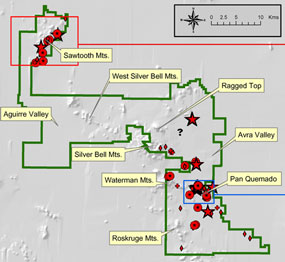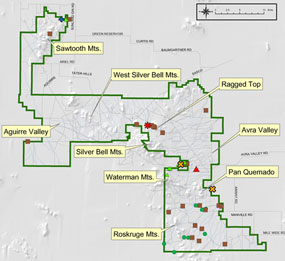Biological Survey of Ironwood Forest National MonumentExotic Plants Assessment The 54 exotic plants constitute 9.6% of the IFNM flora. This compares favorably with the Tucson Mountains flora, 13% of which is exotic (Rondeau et al. 1996). The smaller percentage of exotics probably reflects the lesser degree of human disturbance in Ironwood Forest National Monument. However, there are several exotic species of major concern because of their potential to displace native plants and drastically disrupt community integrity. Action Exotics Buffelgrass: By far the most serious threat to Ironwood Forest National Monument is buffelgrass (Pennisetum ciliare). Since the deliberate introduction of this perennial, shrublike Old World grass into Sonora in the 1960s it has become widespread in the Sonoran Desert. It is even established in such arid habitats as the Pinacate region of northwestern Sonora (Felger 2000). Introduced plants often exhibit a period of latency (Wilson et al., 2002; Ewell 1986). For several decades they maintain small, weak populations and seem to be innocuous. Once they adapt to the new environment, they begin to spread rapidly. Buffelgrass seems to be undergoing an exponential expansion into desert habitats. We noted with alarm that patches of buffelgrass in IFNM increased in areal coverage by seedling establishment during the severe drought of 2001. It may be capable of dramatic increases during wet years, and has a high potential to seriously degrade large areas of desert communities in the Monument.
It is feasible to eradicate buffelgrass, and this should be a high priority to protect the ecological integrity of IFNM. It was successfully controlled in Organ Pipe Cactus National Monument by a concentrated volunteer effort during the 1990s (Rutman and Dickson 2002). Today they need only to pull up occasional new plants from seeds that come in from agricultural fields across the Mexican border. The Arizona Native Plant Society has an active program to eradicate it from the Tucson Mountains (Saguaro National Park West Unit and Tucson Mountains County Park). Efforts must be sustained for at least three years to prevent reestablishment from the soil seed bank. After that it is fairly easy to eliminate new occurrences. Sahara mustard: The second most serious threat is probably Sahara mustard (Brassica tournefortii). This African cool-season annual was first found in the United States in California in 1927 and in Arizona in 1957 (Tellman 2002, Malusa et al. 2003). Since then it has spread rapidly across the low desert Southwest, particularly in sandy soils. Now Sahara mustard almost completely displaces native spring wildflowers in such areas as the Mohawk Dunes and Bouse Dunes in some years (Dimmitt pers. obs. R.S. Felger, pers. comm.). Like buffelgrass, Sahara mustard seems to have recently begun rapid range expansion. Unlike buffelgrass, Sahara mustard is rare in the Monument, though it may be more common in wetter years. We found only two records plus a small population along Mile Wide Road east of the Monument boundary. The habitat in the Monument that is most vulnerable to Sahara mustard is probably the sand flats on the extreme western edge. This area should be monitored annually, and any mustards found should be killed before they set seed. It can be eradicated if action is taken before a seed bank is established (West and Nabhan 2002). Aguirre Valley’s silty soils should also be monitored. The third likely invasion site is along the sandy extension of Manville Road that leads into the Agua Blanca Ranch.
Bermuda grass (Cynodon dactylon) is listed both in the action and established weed lists because we are undecided as to the magnitude of its threat. This Asian perennial has been in the Sonoran Desert region for many years (Tellman 2002), and generally does not invade large areas of undisturbed desert habitat. Once established, however, it is very persistent and spreads slowly. The understory of the riparian community in Honeybee Canyon in the Tortolita Mountains has been severely degraded by a massive infestation of Bermuda grass (Dimmitt pers. obs.). In IFNM we found it almost exclusively in the bottoms of larger washes and sometimes on roadsides. We did not find it around many of the livestock water catchments, but these are ideal places for it to establish dense stands and from which to disperse seeds downstream. A common seed source is Bermuda grass hay. Cattle and horses pass viable seeds in their manure, and seeds may blow off bales if hay is transported through the Monument. At the Desert Museum we almost eliminated Bermuda grass infestations when we stopped using Bermuda grass hay. Control of Bermuda grass is desirable to prevent a possible outbreak in the Monument. Because of its deep stolons, herbicide is the only feasible method of killing it. Fountain grass (Pennisetum setaceum) is currently rare in IFNM, but has become a serious pest in washes and roadsides in the Tucson Mountains and can probably invade the same habitats in the Monument (Chambers and Hawkins no date; Dimmitt pers. obs.). This very drought-tolerant, perennial African grass is also a major problem in southern California and in the Phoenix, Arizona vicinity. Once introduced, it can spread rapidly along roads and washes. It should be watched carefully and eradicated wherever it is found. Lehman lovegrass (Eragrostis lehmanniana) was found only in the Roskruge Mountains and three sites on the adjacent edge of Avra Valley. This perennial African grass requires at least four to six inches of summer rainfall for successful recruitment from seeds (Chambers and Hawkins no date), so it will probably not become a serious pest in IFNM. It volunteers on the grounds of the Arizona-Sonora Desert Museum mostly in areas that are irrigated or receive concentrated runoff. However, control is desirable to lessen the probability of its adapting to drier conditions. Saltcedar and athel tree (Tamarix chinensis and T. aphylla) occur only in the two wettest washes in the area, Cocío and Greene washes. Athel tree needs more water than saltcedar, and probably can’t survive elsewhere in the Monument except perhaps at some water catchments. It is also nearly sterile and rarely volunteers from seed. Saltcedar is a very different plant. It is more drought tolerant and volunteers freely from abundantly-produced seeds. It may be able to invade other washes and definitely could establish in livestock water catchments. It is established in tiny roadside impoundments in extremely arid parts of southeastern California (Dimmitt pers. obs.). Efforts to eradicate both of these African trees are strongly recommended. However, Athel tree is so abundant along many miles of Greene Wash that control may not be feasible. This location is also in a remote corner of the Monument and there are no other suitable habitats nearby. Most Athel trees in Cocío Wash are on ASARCO property, and the wash drains from here through a long section of IFNM. The tree should be monitored for signs of further spread. Tree tobacco (Nicotiana glauca) is also currently rare in the Monument; we found this giant perennial herb only in Greene Wash. It can probably establish in other major washes and livestock catchments, and perhaps roadsides. It occurs in some large washes in Anza-Borrego Desert State Park (California) which is more arid than Ironwood Forest National Monument (Dimmitt pers. obs.). The abundant tiny seeds of this vigorous South American native can be dispersed by wind and water, and large populations can develop in a short time. It should be killed wherever it is found. Malta starthistle (Centaurea melitensis) was found at only one place, on a roadside in Avra Valley. This winter annual from Eurasia is a serious pest in drier areas than Ironwood Forest National Monument (Chambers and Hawkins no date; Van Devender pers. obs.), so we feel it has the potential to become a problem in the Monument. It should be sought and destroyed to prevent an invasion. Established Exotics with no Feasible Control Available The following exotic plants are firmly established in southern Arizona and are often abundant. Most of them also have significantly altered the biological communities where they occur by displacing natives both by physical competition and by supporting fire. No feasible control is known for most of them, but they should be monitored to determine their impact on IFNM. Red brome (Bromus rubens) is a major threat to Sonoran Desertscrub communities above about 3000 feet. It is present at numerous sites in IFNM, but probably will not become abundant. See discussion under Fire Assessment section. Filaree (Erodium cicutarium), London rocket (Sisymbrium irio), and Mediterranean grass (Schismus barbatus) are widespread and common almost throughout the Monument. Filaree was found on nearly every plot. Mediterranean grass would probably be almost as common in years with normal rainfall at least in the lower elevations. London rocket is usually common only under shrubs; otherwise it is probably as ubiquitous as the other two. These three Eurasian winter-growing weeds are undoubtedly displacing native annuals, but at present there is no feasible method of control. Cheeseweed (Malva parviflora), goosefoot (Chenopodium murale), and sowthistles (Sonchus oleraceus and S. asper) were not common during the dry survey period, but are probably abundant in disturbed areas during normal and wetter years. These Eurasian winter annuals can be common enough to displace native species, but no feasible methods of control are known. Unlike the three weeds in the preceding paragraph, these do not grow well in undisturbed habitats. Many other exotic plant species were documented (asterisked species in the flora list). Most of them are rare to uncommon, and at this time present no apparent threat to the ecological integrity of the Monument. Artificial water impoundments, roadsides, campsites, and other disturbed areas should be monitored for the appearance of new exotics or signs of existing species becoming more invasive. Thirty-eight per cent of the 53 nonnative species in the monument were found only in disturbed xeroriparian habitats.
|
|













